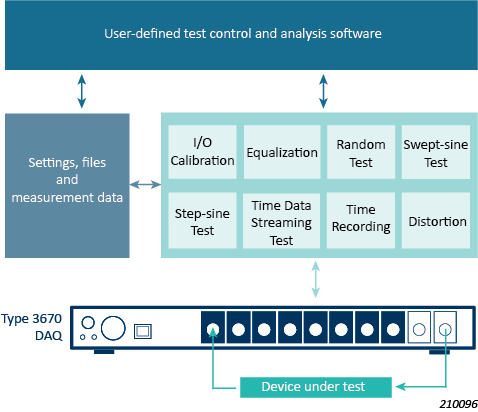Type BZ-7852
Electroacoustic Engine Software
Electroacoustic data acquisition and analysis engine for use with Type 3670 DAQ that can be programmed to produce user defined, automated test applications
Angebot anfordernElectroacoustic (EA) Engine BZ-7852 is an electroacoustic test environment intended to drive Production Test USB DAQ Type 3670 and simplify the measurement of accurate acoustic and vibration data in a production test environment. It can generate final test measurements for further analysis and evaluation, without the need for waveform generation, hardware control or digital signal processing programming experience.
The EA Engine can be operated from the command line or programmatically from popular languages such as C#, MATLAB® or Python® to develop custom user interfaces, and the results can be easily accessed in a range of commercial analysis software as well as Microsoft® Excel®.
USE SCENARIOS
Test software interface to Type 3670 data acquisition hardware for closed-loop measurements on audio devices, for example, create custom software for:
- Repetitive testing for production QA for audio devices with multiple built-in microphones and speakers
- Testing smart devices with voice recognition systems for speech intelligibility and error rates
- Measuring system frequency response and distortion at frequencies up to 40 kHz
- Recording high-resolution time data from a device under test (DUT) under external excitation for post-processing
The EA Engine uses standard Windows command line instructions to access all functionality and setup parameters are stored in XML files allowing simple programming and control from almost any programming environment including C#, MATLAB and Python.
Measurement data is stored in XML or MAT files for simple programmatic access or in CSV files for access, analysis and display in Microsoft Excel.
Time data is stored as calibrated data in WAV, HDF5 or MATLAB for easy post-processing in BK Connect® and many third-party applications.
SYSTEM CALIBRATION
Calibration of all devices connected to the inputs and outputs to produce accurate results in true engineering units is achieved through single command lines and the calibrated values are automatically stored in the system setup XML files.
In addition, the frequency response of sources connected to the outputs can be characterised and corrected to produce a flattened response during subsequent testing.
MEASUREMENT
The EA Engine can perform closed-loop measurement of the frequency response of any audio or vibration device. Tests using step-sine, swept-sine, random or an arbitrary waveform are provided, and the results can be stored as single channel results in narrowband spectra or CPB and cross-channel measurements in many formats including complex FRFs.
For each test, the latency between signal output and signal input is automatically measured and corrected, both for the internal delay and, optionally for the physical distance between source and receiver.
CAPABILITIES

Abonnieren Sie unseren Newsletter zum Thema Schall und Schwingung

